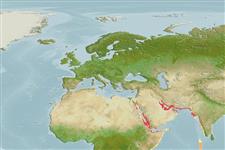>
Blenniiformes (Blennies) >
Tripterygiidae (Triplefin blennies) > Tripterygiinae
Etymology: Enneapterygius: Greek, ennea = nine times + Greek, pterygion = little fin (Ref. 45335).
Environment: milieu / climate zone / depth range / distribution range
Ecologie
marien demersaal; diepte 2 - 12 m (Ref. 88983). Tropical
Western Indian Ocean: Red Sea.
Grootte / Gewicht / Leeftijd
Maturity: Lm ? range ? - ? cm
Max length : 2.1 cm SL mannelijk / geslacht onbekend; (Ref. 88983)
Korte beschrijving
Morfologie | Morfometrie
Dorsale stekels (totaal): 14 - 17; Dorsale zachte stralen (totaal): 8-9; Anale stekels 1; Anale zachte stralen: 15 - 17; Wervels: 32 - 33. Diagnosis: Dorsal fins III + XI-XIII + 8-9 (usually III + XI-XII +8- 9); anal fin I, 15-17 (usually 16); pectoral fin 15: 3+5+7. LL, pored scales8-12; notched scales 21-23, starting at 2 scale rows below the end of the pored series; total lateral scales 28-29; transverse scales 2/5; nape with scales, abdomen scaleless, single row of scales at base of pectoral fin. Body depth 4.5-5.2 in SL. Vertebrae 10 + 21-22. Dentary pores 3 + 2 + 3; head 3.1-3.4 in SL; eye 2.5-3.0 in head length; orbital cirrus minute, rounded flap about half the diameter of pupil, distally serrated margin; supratemporal sensory canal crescent-shaped; first dorsal fin same height in males and females, about 60% of the second. Key features are: body bars brown; caudal peduncle spots 2 black, the lower one smaller; five black blotches on anal fin, anteriormost largest and darkest; face pink with brown bar below eye; first dorsal fin crimson in males (Ref. 57774, 88983).
Adults inhabit bays and lagoons rich in corals, 2-12 m; usually found in crevices near Porites or on the vertical face of this coral (Ref. 88983). Eggs are hemispherical and covered with numerous sticky threads that anchor them in the algae on the nesting sites (Ref. 240). Larvae are planktonic which occur primarily in shallow, nearshore waters (Ref. 94114).
Levenscyclus en paargedrag
Maturiteit | Voortplanting | Paaien | Eieren | Fecunditeit | Larven
Holleman, W. and S.V. Bogorodsky, 2012. A review of the blennioid fish family Tripterygiidae (Perciformes) in the Red Sea, with description of Enneapterygius qirmiz, and reinstatement of Enneapterygius altipinnis Clark, 1980. Zootaxa 3152:36-60. (Ref. 88983)
Status op de Rode Lijst van het IUCN (Ref. 130435)
Gevaar voor de mens
Harmless
Gebruik door de mens
Meer informatie
Lokale namenSynoniemenMetabolismePredatorenEcotoxicologieVoortplantingMaturiteitPaaienPaaiaggregatiesFecunditeitEierenOntwikkeling van de eieren
ReferentiesAquacultuurAquacultuurprofielKweeklijnenGeneticaElectrophoresesErfelijkheidZiektesVerwerkingNutrientsMassaconversie
Tools
Speciale rapporten
Download XML
Internetbronnen
Estimates based on models
Preferred temperature (Ref.
123201): 24.8 - 29.3, mean 28.2 °C (based on 202 cells).
Fylogenetische diversiteitsindex (Ref.
82804): PD
50 = 0.5000 [Uniqueness, from 0.5 = low to 2.0 = high].
Bayesian length-weight: a=0.00794 (0.00346 - 0.01822), b=3.08 (2.88 - 3.28), in cm total length, based on LWR estimates for this (Sub)family-body shape (Ref.
93245).
Trofisch niveau (Ref.
69278): 3.0 ±0.3 se; based on size and trophs of closest relatives
Weerstandsvermogen (Ref.
120179): Hoog, minimale populatieverdubbelingstijd minder dan 15 maanden (Preliminary K or Fecundity.).
Fishing Vulnerability (Ref.
59153): Low vulnerability (10 of 100).
